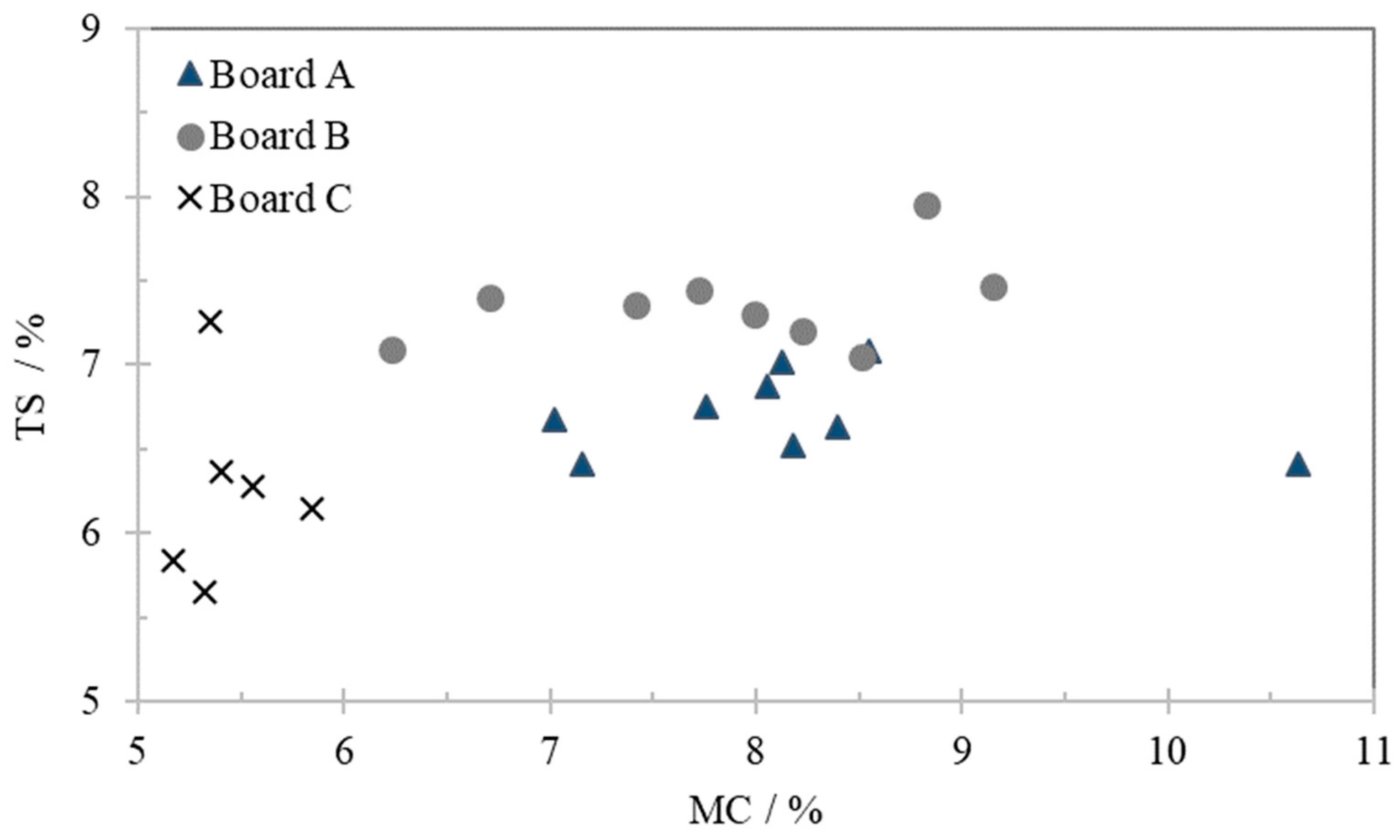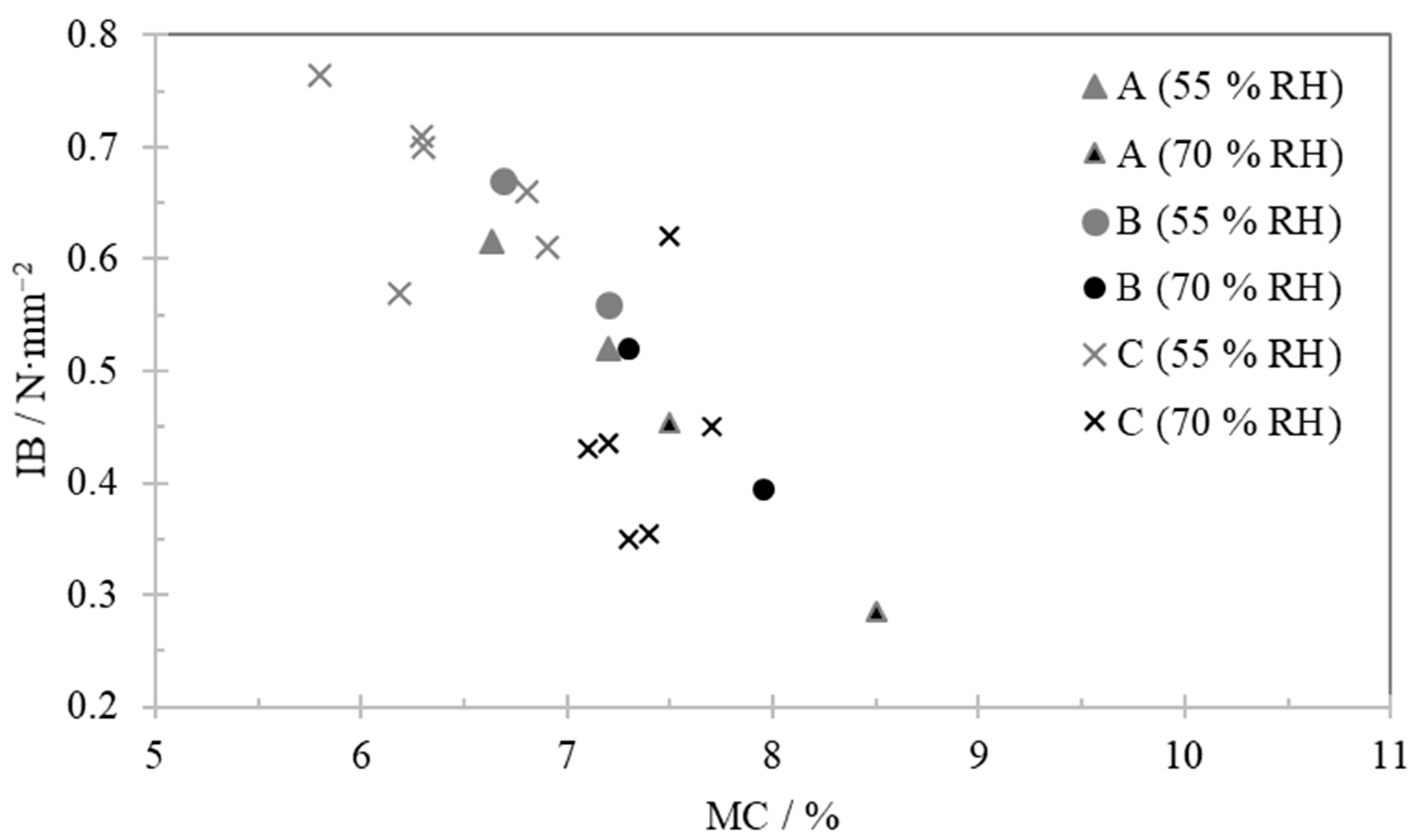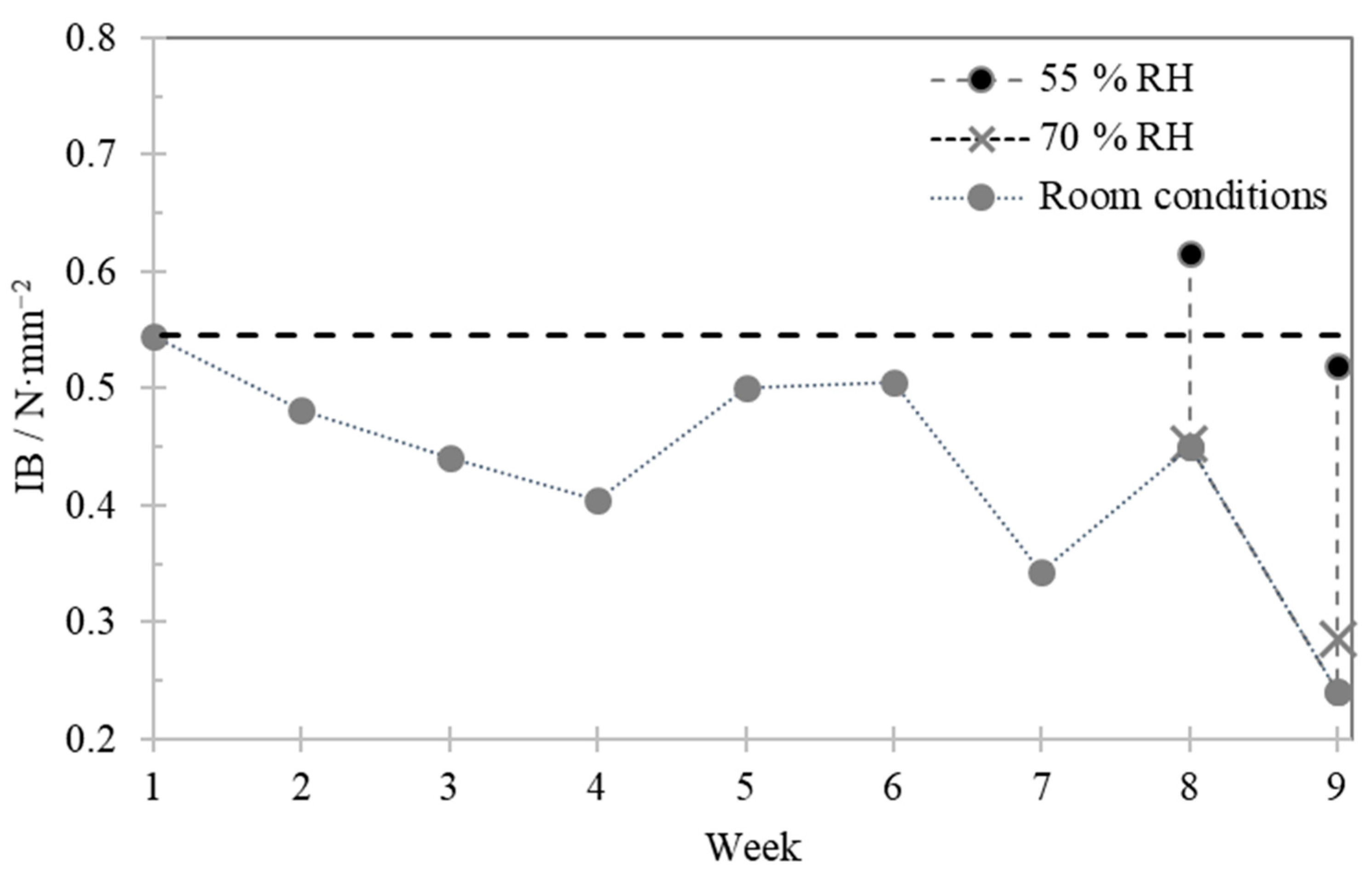Effect of Panel Moisture Content on Internal Bond Strength and Thickness Swelling of Medium Density Fiberboard
Abstract
1. Introduction
2. Materials and Methods
2.1. Test Samples
2.2. Determination of Physico-Mechanical Properties
3. Results and Discussion
3.1. Thickness Swelling
3.2. Internal Bond Strength
4. Conclusions
Author Contributions
Funding
Institutional Review Board Statement
Informed Consent Statement
Data Availability Statement
Conflicts of Interest
References
- EN 622–5. Fiberboards—Specifications. Part 5. Requirements for Dry Process Boards; European Standard, CEN: Brussels, Belgium, 2009. [Google Scholar]
- Dunky, M. Urea–formaldehyde (UF) adhesive resins for wood. Int. J. Adhes. Adhes. 1998, 18, 95–107. [Google Scholar] [CrossRef]
- Carvalho, L.M.; Costa, M.R.; Costa, C. Modeling and Simulation of the Hot-Pressing Process in the Production of Medium Density Fiberboard (MDF). Chem. Eng. Comm. 1998, 170, 1–21. [Google Scholar] [CrossRef]
- Carvalho, L.M.; Martins, J.; Costa, C. Transport Phenomena. In Wood-Based Panels: An Introduction for Specialists; Thoemen, H., Irle, M., Sernek, M., Eds.; Brunel University Press: London, UK, 2010; pp. 123–176. ISBN 9781902316826. [Google Scholar]
- Wood Handbook—Wood as an Engineering Material; General Technical Report FPL-GTR-190; Department of Agriculture, Forest Service, Forest Products Laboratory: Madison, WI, USA, 2010; p. 508.
- Maloney, T.M. Modern Particleboard & Dry-Process Fiberboard Manufacturing; Miller Freeman Publications: San Francisco, CA, USA, 1977; ISBN 9780879300630. [Google Scholar]
- Grigsby, W.; Thumm, A.; Carpenter, J. Fundamentals of MDF Panel Dimensional Stability: Analysis of MDF High-Density Layers. J. Wood Chem. Technol. 2012, 32, 149–164. [Google Scholar] [CrossRef]
- IARC. Formaldehyde, 2-Butoxyethanol and 1-tertButoxypropan-2-ol. In Monographs on the Evaluation of Cancinogenic Risk to Humans; World Health Organization—International Agency for Research on Cancer: Lyon, France, 2006; Volume 88. [Google Scholar]
- Costa, N.A.; Pereira, J.; Ferra, J.; Cruz, P.; Martins, J.; Magalhães, F.D.; Mendes, A.; Carvalho, L.H. Formaldehyde emission in wood based panels: Effect of curing reactions. Int. Wood Prod. J. 2014, 5, 146–150. [Google Scholar] [CrossRef]
- Pizzi, A. Urea-formaldehyde Resins. In Handbook of Adhesive Technology; Pizzi, A., Mittal, K.L., Eds.; M. Dekker: New York, NY, USA, 1994; ISBN 9780824789749. [Google Scholar]
- Ferra, J.M.; Mena, P.C.; Martins, J.; Mendes, A.M.; Costa, M.R.N.; Magalhães, F.D.; Carvalho, L.H. Optimization of the Synthesis of Urea-Formaldehyde Resins using Response Surface Methodology. J. Adhes. Sci. Technol. 2010, 24, 1454–1471. [Google Scholar] [CrossRef]
- Ghani, A.; Ashaari, Z.; Bawon, P.; Lee, S.H. Reducing formaldehyde emission of urea formaldehyde-bonded particleboard by addition of amines as formaldehyde scavenger. Build. Environ. 2018, 142, 188–194. [Google Scholar] [CrossRef]
- EN 622–1. Fiberboards—Specifications. Part 1. General Requirements; European Standard, CEN: Brussels, Belgium, 2003. [Google Scholar]
- California Air Resources Board (CARB). Airborne toxic control measure to reduce formaldehyde emission from composite wood products. Health and safety code: Title 17. In California Code of Regulations; California Office of Administrative Law: Sacramento, CA, USA, 2009. [Google Scholar]
- Baileys, J.; Marks, B.; Ross, A.; Crawford, D.; Krzysik, A.; Muehl, J.; Youngquist, J. Providing moisture and fungal protection to wood-based composites. For. Prod. J. 2003, 53, 76–81. [Google Scholar]
- Garcia, R.A.; Cloutier, A.; Riedl, B. Dimensional stability of MDF panels produced from fibres treated with maleated polypropylene wax. Wood Sci. Technol. 2005, 39, 630–650. [Google Scholar] [CrossRef]
- Roger, R.E. The Chemistry of Solid Wood; Wood Science & Technology: Washington, DC, USA, 1984; Volume 19, pp. 17–18. [Google Scholar]
- Bandel, A. Gluing Wood; Catas srl: Udine, Italy, 1995. [Google Scholar]
- Niemz, P. Wood-Water Interaction. In Wood-Based Panels: An Introduction for Specialists; Thoemen, H., Irle, M., Sernek, M., Eds.; Brunel University Press: London, UK, 2010; pp. 95–122. ISBN 9781902316826. [Google Scholar]
- Venkateswaran, A. Sorption of aqueous and nonaqueous media by wood and cellulose. Chem. Rev. 1970, 70, 619–637. [Google Scholar] [CrossRef]
- Time, B. Studies on hygroscopic moisture transport in Norway spruce (Picea abies) Part 2: Modelling of transient moisture transport and hysteresis in wood. Holz Als Roh-Und Werkstoff 2002, 60, 405–410. [Google Scholar] [CrossRef]
- Suomi-Lindberg, L.; Pulkkinen, P.; Nussbaum, R. Chapter 5—Influence of the wood component on the bonding process and the properties of wood products. In COST Action E13-Wood Adhesion and Glued Products. State of the Art—Report; European Standard, CEN: Brussels, Belgium, 2002; pp. 121–143. [Google Scholar]
- EN 317. Particleboards and Fiberboards—Determination of Swelling in Thickness after Immersion in Water; European Standard, CEN: Brussels, Belgium, 1993. [Google Scholar]
- EN 319. Particleboards and Fiberboards—Determination of Tensile Strength Perpendicular to the Plane of the Board; European Standard, CEN: Brussels, Belgium, 1993. [Google Scholar]
- EN 322. Wood-Based Panels—Determination of Moisture Content; European Standard, CEN: Brussels, Belgium, 1993. [Google Scholar]
- EN 323. Wood-Based Panels—Determination of Density; European Standard, CEN: Brussels, Belgium, 1993. [Google Scholar]
- Dunky, M.; Pizzi, A. Chapter 23—wood adhesives. In Adhesion Science and Engineering; Chaudhury, M., Pocius, A.V., Eds.; Elsevier Science B.V.: Amsterdam, The Netherlands, 2002; pp. 1039–1103. [Google Scholar]
- Imtiaz, A.; Jayaraman, K.; Bhattacharyya, D. Effects of resin and moisture content on the properties of medium density fibreboards made from kenaf bast fibres. Ind. Crop. Prod. 2014, 52, 191–198. [Google Scholar] [CrossRef]
- Halvarsson, S.; Edlund, H.; Norgren, M. Properties of medium-density fibreboard (MDF) based on wheat straw and melamine modified urea formaldehyde (UMF) resin. Ind. Crop. Prod. 2008, 28, 37–46. [Google Scholar] [CrossRef]
- Carvalho, L.M.; Costa, M.R.; Costa, C. Modeling Rheology in the Hot-pressing of MDF: Comparison of Mechanical Models. Wood Fiber Sci. 2001, 33, 395–411. [Google Scholar]




| Sample | Density (kg·m−3) | Thickness (mm) |
|---|---|---|
| A—CARB II board | 689 ± 3 | 19.24 ± 0.16 |
| B—E1 board | 692 ± 4 | 19.48 ± 0.15 |
| C—CARB II board | 763 ± 6 | 19.13 ± 0.03 |
| Stored at Room Temperature and RH (Non-Fixed Conditions) | |||||||||
|---|---|---|---|---|---|---|---|---|---|
| A | B | C | |||||||
| Week | MC | IB | TS | MC | IB | TS | MC | IB | TS |
| 1 | 7.2 | 0.55 | 6.4 | 6.2 | 0.65 | 7.1 | 5.3 | 0.68 | 5.7 |
| 2 | 7.8 | 0.48 | 6.8 | 7.4 | 0.58 | 7.4 | 5.3 | 0.64 | 7.3 |
| 3 | 8.1 | 0.44 | 7.0 | 8.0 | 0.49 | 7.3 | 5.4 | 0.76 | 6.4 |
| 4 | 8.4 | 0.41 | 6.6 | 8.5 | 0.41 | 7.1 | 5.8 | 0.72 | 6.1 |
| 5 | 7.0 | 0.50 | 6.7 | 6.7 | 0.61 | 7.4 | 5.6 | 0.71 | 6.3 |
| 6 | 8.1 | 0.51 | 6.9 | 7.7 | 0.56 | 7.4 | 5.2 | 0.76 | 5.8 |
| 7 | 8.6 | 0.34 | 7.1 | 8.8 | 0.49 | 7.9 | --- | --- | --- |
| 8 | 8.2 | 0.45 | 6.5 | 8.2 | 0.46 | 7.2 | --- | --- | --- |
| 9 | 10.6 | 0.24 | 6.4 | 9.2 | 0.33 | 7.5 | --- | --- | --- |
| Stdev | ±0.2 | ±0.04 | ±0.1 | ±0.3 | ±0.05 | ±0.3 | ±0.1 | ±0.05 | ±0.2 |
| Stored at 20 °C, 55% RH | Stored at 20 °C, 70% RH | |||||||||||
|---|---|---|---|---|---|---|---|---|---|---|---|---|
| A | B | C | A | B | C | |||||||
| Week | MC | IB | MC | IB | MC | IB | MC | IB | MC | IB | MC | IB |
| 1 | --- | --- | --- | --- | 6.3 | 0.70 | --- | --- | --- | --- | 7.3 | 0.35 |
| 2 | --- | --- | --- | --- | 5.8 | 0.77 | --- | --- | --- | --- | 7.1 | 0.43 |
| 3 | --- | --- | --- | --- | 6.3 | 0.71 | --- | --- | --- | --- | 7.2 | 0.44 |
| 4 | --- | --- | --- | --- | 6.2 | 0.57 | --- | --- | --- | --- | 7.7 | 0.45 |
| 5 | --- | --- | --- | --- | 6.9 | 0.61 | --- | --- | --- | --- | 7.4 | 0.36 |
| 6 | --- | --- | --- | --- | 6.8 | 0.66 | --- | --- | --- | --- | 7.5 | 0.62 |
| 7 | --- | --- | --- | --- | --- | --- | --- | --- | --- | --- | --- | --- |
| 8 | 6.7 | 0.62 | 6.7 | 0.67 | --- | --- | 7.5 | 0.45 | 7.3 | 0.52 | --- | --- |
| 9 | 7.2 | 0.52 | 7.2 | 0.56 | --- | --- | 8.5 | 0.29 | 8.0 | 0.40 | --- | --- |
| Stdev | ±0.04 | ±0.02 | ±0.08 | ±0.02 | ±0.24 | ±0.04 | ±0.14 | ±0.02 | ±0.07 | ±0.02 | ±0.16 | ±0.04 |
Publisher’s Note: MDPI stays neutral with regard to jurisdictional claims in published maps and institutional affiliations. |
© 2020 by the authors. Licensee MDPI, Basel, Switzerland. This article is an open access article distributed under the terms and conditions of the Creative Commons Attribution (CC BY) license (http://creativecommons.org/licenses/by/4.0/).
Share and Cite
Magalhães, R.; Nogueira, B.; Costa, S.; Paiva, N.; Ferra, J.M.; Magalhães, F.D.; Martins, J.; Carvalho, L.H. Effect of Panel Moisture Content on Internal Bond Strength and Thickness Swelling of Medium Density Fiberboard. Polymers 2021, 13, 114. https://doi.org/10.3390/polym13010114
Magalhães R, Nogueira B, Costa S, Paiva N, Ferra JM, Magalhães FD, Martins J, Carvalho LH. Effect of Panel Moisture Content on Internal Bond Strength and Thickness Swelling of Medium Density Fiberboard. Polymers. 2021; 13(1):114. https://doi.org/10.3390/polym13010114
Chicago/Turabian StyleMagalhães, Roberto, Beatriz Nogueira, Samaritana Costa, Nádia Paiva, João M. Ferra, Fernão D. Magalhães, Jorge Martins, and Luisa H. Carvalho. 2021. "Effect of Panel Moisture Content on Internal Bond Strength and Thickness Swelling of Medium Density Fiberboard" Polymers 13, no. 1: 114. https://doi.org/10.3390/polym13010114
APA StyleMagalhães, R., Nogueira, B., Costa, S., Paiva, N., Ferra, J. M., Magalhães, F. D., Martins, J., & Carvalho, L. H. (2021). Effect of Panel Moisture Content on Internal Bond Strength and Thickness Swelling of Medium Density Fiberboard. Polymers, 13(1), 114. https://doi.org/10.3390/polym13010114







